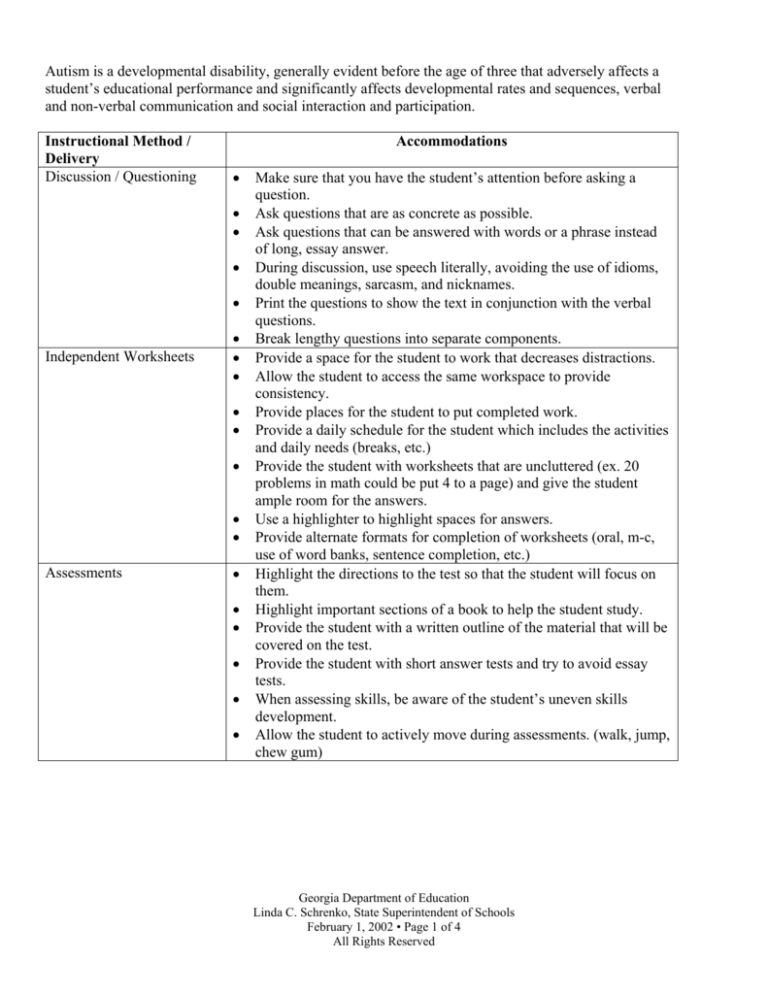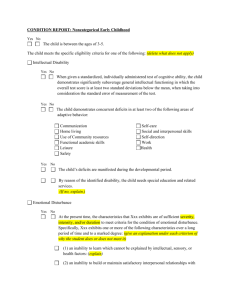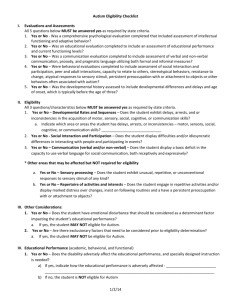
AUTISM
Autism is a developmental disability, generally evident before the age of three that adversely affects a
student’s educational performance and significantly affects developmental rates and sequences, verbal
and non-verbal communication and social interaction and participation.
Instructional Method /
Delivery
Discussion / Questioning
Accommodations
•
•
•
•
•
Independent Worksheets
•
•
•
•
•
•
•
•
Assessments
•
•
•
•
•
•
Make sure that you have the student’s attention before asking a
question.
Ask questions that are as concrete as possible.
Ask questions that can be answered with words or a phrase instead
of long, essay answer.
During discussion, use speech literally, avoiding the use of idioms,
double meanings, sarcasm, and nicknames.
Print the questions to show the text in conjunction with the verbal
questions.
Break lengthy questions into separate components.
Provide a space for the student to work that decreases distractions.
Allow the student to access the same workspace to provide
consistency.
Provide places for the student to put completed work.
Provide a daily schedule for the student which includes the activities
and daily needs (breaks, etc.)
Provide the student with worksheets that are uncluttered (ex. 20
problems in math could be put 4 to a page) and give the student
ample room for the answers.
Use a highlighter to highlight spaces for answers.
Provide alternate formats for completion of worksheets (oral, m-c,
use of word banks, sentence completion, etc.)
Highlight the directions to the test so that the student will focus on
them.
Highlight important sections of a book to help the student study.
Provide the student with a written outline of the material that will be
covered on the test.
Provide the student with short answer tests and try to avoid essay
tests.
When assessing skills, be aware of the student’s uneven skills
development.
Allow the student to actively move during assessments. (walk, jump,
chew gum)
Georgia Department of Education
Linda C. Schrenko, State Superintendent of Schools
February 1, 2002 • Page 1 of 4
All Rights Reserved
AUTISM
Autism is a developmental disability, generally evident before the age of three that adversely affects a
student’s educational performance and significantly affects developmental rates and sequences, verbal
and non-verbal communication and social interaction and participation.
Instructional Method /
Delivery
Centers
Accommodations
•
•
•
•
•
•
•
•
•
•
Projects
•
•
•
•
Reports
•
•
•
Reading
•
•
•
•
•
If a center consists of listening to music, provide the written or
picture symbol words to the song to provide the student with a
visual cue.
Provide the student with method of recognizing when the task is
complete and what task is next.
Structure the centers so they are not distracting.
Provide picture cues or written steps to the directions for completing
each centers activity.
Label or mark work areas so that the student can manipulate the
schedule independently.
Make sure the student’s materials are clearly marked for him or her
and easily accessible.
Make the center areas easily accessible during transition times.
Schedule activities so that a preferred activity follows a nonpreferred activity.
When giving directions for the activities, make sure that the
expectations are very clear to the student.
Provide multiple cues that an activity is ending to assist with
transition issues.
Use samples or pictures of finished products to show the student
what needs to be done.
Allow students to work with a peer.
Provide visual cues of various elements/tasks within the project.
Allow the student to prepare/tape presentation rather than having to
do it “live”.
Provide schedule of steps to be completed in correct sequence.
Provide an outline for the students to work with/from.
For oral reports allow the student opportunities to practice and roleplay.
Read to the student: Poetry, songs, etc. with strong rhythm and
rhyme can be more effective.
Allow the student to listen to the story or chapter on tape (as
tolerated) to reduce external stimuli.
Provide choices of reading materials.
Encourage students to explore into new topics.
Reduce amount of graphics in reading material for students who are
visually distractible.
Georgia Department of Education
Linda C. Schrenko, State Superintendent of Schools
February 1, 2002 • Page 2 of 4
All Rights Reserved
AUTISM
Autism is a developmental disability, generally evident before the age of three that adversely affects a
student’s educational performance and significantly affects developmental rates and sequences, verbal
and non-verbal communication and social interaction and participation.
Instructional Method /
Delivery
Writing
Accommodations
•
•
•
•
•
•
•
•
Drawing
•
•
•
Groups
•
•
•
•
•
Note-taking
Presentation
•
•
•
•
•
•
•
Slant board can provide compensation for vestibular difficulties. Use
commercial or homemade (4” binder).
Use letters of various textures such as plastic, wood, or foam. This
allows the student to feel the letters.
Allow the student to use a vibrating pen/weighted pen/felt tip pen.
Allow the student to use raised line paper to increase proprioceptive
input to cue for line usage.
Allow the student to use a word processing computer program
whenever possible.
Allow the student to write about favorite topics whenever possible.
If student has an aversion to handwriting, let him do the work using
a keyboard solution or by tape-recording the work.
Encourage text to speech, Color adjustment, illustrations, etc. to
motivate the student to write.
Use adapted drawing utensils
Use a variety of drawing utensils. (markers, paintbrushes, stamps)
Provide a variety of textures under the paper to provide the student
with feedback as opposed to the flat surface.
Require the student to stay in the group for the activities that are
meaningful to them.
Provide the student with a transition warning before group activities
begin. (Hand the student a transition object, allow the student to ring
a bell for the class to go to groups, use a verbal 5 minute warning,
etc.)
Allow the student to leave the group before becoming frustrated.
Provide the student with a sequence for the group activities (written
or pictures).
Make sure that the student can complete the activity independently
before moving to the shared activity group situation.
Allow a peer to photocopy the class notes to share with the student.
Allow the student to tape record the discussion/lecture.
Provide the student with an outline of the class discussion.
Allow the student to access a computer to take notes.
Accept oral answers, taped or video presentation materials.
Give the student a written outline of what is expected and a sample
of a finished product to follow.
Allow presentation to be delivered in small chunks to help with
anxiety.
Georgia Department of Education
Linda C. Schrenko, State Superintendent of Schools
February 1, 2002 • Page 3 of 4
All Rights Reserved
AUTISM
Autism is a developmental disability, generally evident before the age of three that adversely affects a
student’s educational performance and significantly affects developmental rates and sequences, verbal
and non-verbal communication and social interaction and participation.
Instructional Method /
Delivery
Computers
Accommodations
•
Place the computer keyboard close to the screen so that they can be
seen simultaneously.
• Use a roller ball/tracking ball with a separate button (track ball
mouse.
• Allow the student to use Intellikeys that often helps reduce visual
distractions. Could use enlarged adhesive letters on a regular
keyboard.
• Encourage the students to wear headphones to minimize distractions
and maximize clarity of sounds.
• Consider the use of bold key labels and primary keyboards in ABC
order if keyboard awareness skills are not developing using the
standard equipment.
• Use a desktop security program to prevent the student from
accessing prohibited areas while he is to be completing schoolwork.
• Make sure monitor is at eye level.
• Make sure mouse and keyboard are accessible and at the proper
height.
* If the accommodations do not seem appropriate for the student, remember to check other disability
areas.
Georgia Department of Education
Linda C. Schrenko, State Superintendent of Schools
February 1, 2002 • Page 4 of 4
All Rights Reserved









